Eggs:
Eggs are used in many meals and recipes. Here are the basics.
Hard Boiled Eggs
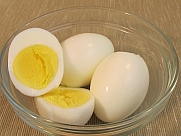
Place eggs in a saucepan large enough to accommodate them in a single layer. Fill the pan with cold water, covering the eggs by 1 inch. Bring the water to a rolling boil over a medium-high heat. Turn off the heat, cover, and let stand 2 minutes for soft-boiled eggs, 4 minutes for medium-boiled, and 12 minutes for hard-boiled. Once the eggs are done, rinse and fill the pan with cold water; let stand for 2 minutes. Crack the shell all over by gently rolling egg against a hard surface. Peel starting at the wide end, there will generally be a small air pocket there. Rinse under cold, running water to remove any shell fragments. Yolks should be all yellow. If they have a gray outer layer, they were overcooked.
Easy peel method: Use a steamer! Fill the steamer assembly with about an inch of water and bring to a boil. Place the cold eggs in the steamer basket in a single layer. Be careful not to crack any shells or egg will ooze out while cooking. Cover and steam for 13 minutes. Cool and peel as described above. Shells will slip off effortlessly.
Tip: Fresh eggs are nearly impossible to peel. Use eggs that are at least a few days old. Also, adding ½ tsp baking soda per quart of water makes them easier to peel.
Fried Eggs
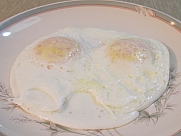
A good non-stick 8" fry pan is a must. Heat the pan to a medium heat (approx 6 on a scale of 1-10) and add about a Tbsp of oil. Butter gives a nice taste but to minimize saturated fat and maximize unsaturated fat, oil is healthier. Canola is preferred because it doesn't leave a taste like olive or peanut oil can. Crack the eggs into the oil. As soon as the bottom surface is solid enough so that the eggs all move around the pan as one piece, its time to flip it. In a flipping motion, roll the eggs up and over the edge opposite the handle. The yolks should basically pivot in the corner of the pan. If the eggs get airborne, there's a good chance the yolks will break on impact. So, keep it as low as possible. Flip again and slide off onto a plate to serve. Use a spatula if the flipping part is difficult. Eggs should be smooth white without any brown crusty areas.
Tip: The trick is medium level heat. If the heat is too high (a lot of sizzling and popping noices), it will brown on the outsides before the inside cooks through. If the heat is too low, the eggs will not slide around the pan easily.
Scrambled Eggs
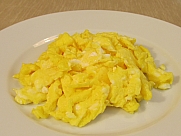
For this you need a good heat resistant rubber spatula. Heat a non-stick fry pan to a medium heat (approx 6) and add about a Tbsp of oil. Beat the eggs with a fork in a small bowl then pour into the oil. Using the rubber spatula, constantly pull in from the sides, allowing the liquid egg to flow out onto the exposed fry pan surface. When fairly cooked on one side, flip and chop up into pieces. Slide off onto a plate. Eggs should be yellow with no brown crispy or visible oil.
Tip: For a slightly fluffier and lighter egg, beat in 1 Tbsp milk for each 2 eggs at the start.
Poached Eggs
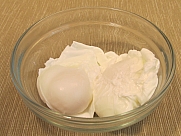
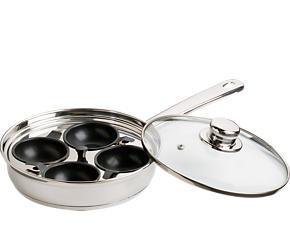
If you will be poaching eggs on a regular basis, it's better to buy a poacher. This actually steams the eggs but it gives a nice shape and easy cleanup. One with 4 non-stick cups (not plastic) with easy grab handles and a glass lid would be good. Just spray the cup with canola oil spray, drop in the egg, cook to the desired consistency. About 3 minutes for cooked whites and a soft yolk. Great for poached egg on toast.
The boiling water method is messy but if you must... Fill a sauce pan with about 3 inches of water and bring to a boil. Add in 1 Tbsp white vinegar. This will help keep the whites from spreading out in the water. Turn the heat down to just below a boil (3). Crack the egg into a small dish then bring the dish to the surface of the water and gently slide the egg into the water. After 4 minutes, remove from the water using a large slotted spoon, drain before putting on toast, polenta, grits etc.
Omelets
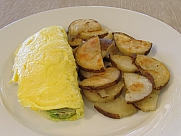
Heat a non-stick 8" fry pan to a medium heat (approx 6) and add about 2 Tbsp of oil. If you will use mushrooms, olives, onions, chilies or bell peppers, add them to the oil and sauté for a few moments until they are lightly cooked. Beat two eggs with a fork in a small bowl then pour over the sautéed vegetables. Using a rubber spatula, constantly pull in from the sides, allowing the liquid egg to flow out onto the exposed fry pan surface. When the bottom is fairly cooked (top will still be liquidy), flip and remove from the heat. The other side will continue to cook while you are adding the fillings. Add any fillings (like cheese, beans, avocado, sour cream) that will go in the omelet. Put the filling on the left side only (if you are right handed) starting with the cheese. Putting the cheese next to the hot egg will help it melt. Slide the omelet out of the left side of the pan onto a plate and at the same time rolling the pan over enough to fold the omelet in half, enclosing the filling. Again when done right, the eggs should be fluffy and yellow with no brown crispy.
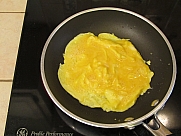 |
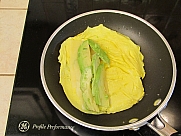 |
|
| Ready to flip. | Flipped, off heat, add fillings. |
Egg Salad
See Egg Salad Sandwich.

Post a Comment